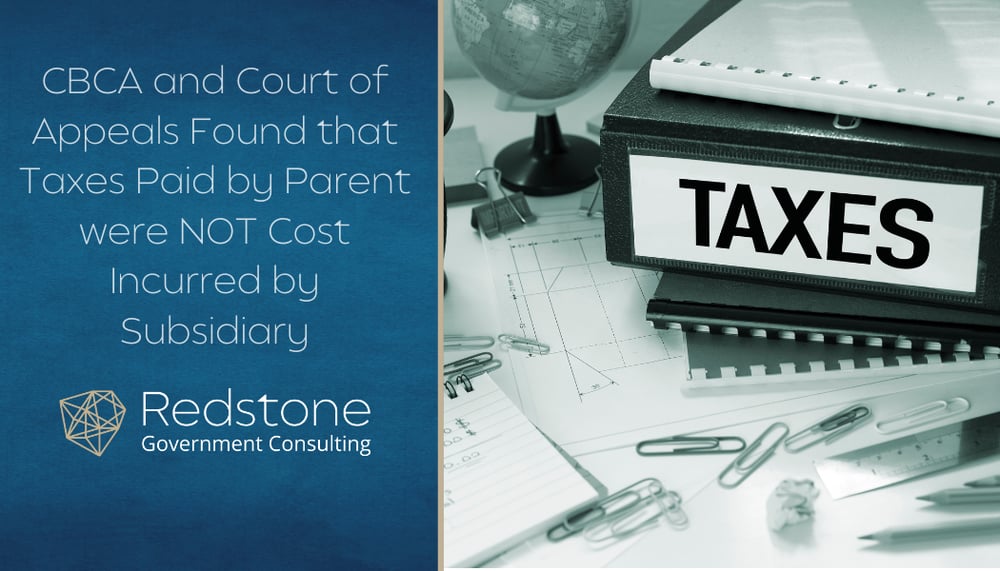
The Court of Appeals decision came out on June 26, 2024, and I have been trying work it through my head how they got to their decision. I for sure do not have an answer but I have come up with some ideas and concerns. International Development Solutions, LLC v. Secretary of State, U.S. Court of Appeals, Federal Circuit, 68 CCF ¶82,658, (Jun. 26, 2024)
BIG CONCERN – What will our friendly DCAA auditors do with this case? Remember “rules are rules” and if DCAA see a precedence set by this case – they will make it a RULE.
A Little Background on the Case
The contractor that submitted the claim to the Civilian Board of Contract Appeals (CBCA) was International Development Solutions, LLC (IDS). IDS and the Department of State (DOS) entered into the subject contract in September 2010. IDS was a Joint Venture between ACADEMI Training Center, Inc. (ATCI) and Kaseman, LLC. In May of 2012, ATCI bought out Kaseman and became the sole owner of IDS. That same month ATCI submitted a novation request to DOS requesting that ATCI be recognized as the successor-in-interest, which was denied. So, ATCI maintained IDS as a wholly owned subsidiary and continued contract performance.
By the way – ATCI was a wholly owned subsidiary of ACADEMI LLC. In 2014, Constellis Holdings LLC (Constellis) acquired ACADEMI LLC, through one of its several subsidiaries. IDS claimed that corporate taxes were determined and paid at the ACADEMI and Constellis level.
In June of 2012 the Afghan Ministry of Finance started a tax audit of ACADEMI and Constellis. In 2017 ACADEMI and Constellis negotiated a settlement related to the tax audit for $36M and made payments to the Afghan Ministry of Finance.
This is where our story takes a dark turn. IDS submits several claims to DOS for recovery of the $36M as IDS believed it was the IDS contract revenues that drove the additional taxes levied against the parent company (i.e., ACADEMI and Constellis). Neither the CBCA nor Court of Appeals addressed the question of whether the IDS contract revenues resulted in the additional taxes paid. Instead, the Judges turned to whether the taxes paid by the parent company was an incurred cost by the subsidiary.
The CBCA started with and the Court of Appeals stayed with determining whether IDS incurred the cost based on the requirements set forth is FAR 31.201-2(a) that a cost be reasonable; allocable; recorded based on applicable accounting standards or principles; and in compliance with terms of the contract and FAR part 31. Additionally, the Board and Court noted per FAR 31.201-2(d) the contractor is responsible for accounting for costs and maintaining documentation to support the costs.
This is where things go down the rabbit hole. Both the Board and Court did find the evidence sufficient to support that IDS incurred the cost. The Court states “Reasonable minds can conclude that the physical evidence provided by IDS adequately demonstrates that IDS's ultimate parent companies, and not IDS, incurred the tax costs at issue in this appeal. Therefore, substantial evidence supports the Board's determination that the taxes paid were costs incurred by entities higher in IDS's ownership chain, rather than by IDS.”
What I Think the Case Should Have Been Based On
As the Court of Appeals states “an incurred cost is not eligible for reimbursement from the government unless it is ‘properly allocable to the contract’ and ‘allowable’ as defined by FAR Part 31.” Let’s start with allowability. FAR 31.205-41, Taxes, simply put makes tax expenses, other than US Federal income taxes, allowable unless the fact that the contract with the US Government would create an exemption from the tax. So, it would appear the Afghan tax should be allowable. Now we turn to allocability. If the documentation supporting the additional tax levy could be shown to have resulted from the IDS contract revenue – one would think the cost was allocable to IDS and its contracts that generated the revenue.
Even using the FAR 31.201-2(a) requirement used by the Board:
- One would presume the amount of the tax as agreed to by the Afghan Ministry of Finance, an unrelated third-party, would be considered reasonable;
- If the IDS contract revenue was the basis of the tax it would be allocable to IDS;
- The amounts paid were recorded in the period the liability was determined based on applicable accounting standards or principles; and
- Neither the terms of the contract nor FAR part 31 make the cost unallowable.
Making the Cost Properly “Incurred”
Even though the requirement of CAS 403 may not have been applicable to the DOS contract with IDS, the concepts in CAS 9904.403-61 Interpretation make it clear that the Government expects a home office (i.e., parent or higher-level organization) to “incur” tax expenses that are allowable and allocable to business units where the contracts are performed. Additionally, there have been other cases (e.g., General Motors Corporation, Detroit Diesel Allison Division v. Les Aspin, Secretary of Defense, U.S. Court of Appeals, Federal Circuit, (Apr. 29, 1994) and United States v. Lockheed Corporation and Lockheed Missiles and Space Co., U.S. Court of Appeals, Federal Circuit, (Apr. 15, 1987)) with taxes paid (i.e., incurred) by a home office and allocated to its business units. These cases focused on the allocation method not whether the cost was an incurred cost of the business unit receiving the allocated tax expenses.
Where the train went off the tracks I have no idea.
My Concerns
Will DCAA expect a greater level of documentation to support the allocation of taxes, or for that matter any cost, paid by a parent (i.e., home office) that are then allocated to a subsidiary (i.e. segment or business unit)?
Joint Ventures often do not exist in your accounting records shortly after the contract performance ends. You may need to hold them open for extended periods just in case.
Unpopulated Joint Ventures often get services and expenses from the venturing partners on a transactional basis rather than being included in the allocation bases of the venturing partners’ parent companies – will DCAA see these cost as not being “incurred” by the Joint Venture.
Getting your final indirect rates established quickly through a low-risk memo is great but remember the Government has FAR 31.201-5 (affectionally known as the Credits Clause) to recover any tax refunds you may get. This is a one-way street – additional taxes are not necessarily recoverable.
Takeaway
When you make an argument or take a position that may go to litigation – Make sure it is the right one.
Redstone GCI can assist your company in several ways, including formulating positions to support your costs to the government, reviewing these positions before submission to ensure accuracy and compliance, and providing expert witness support during litigation. This comprehensive approach ensures that your company is well-prepared and represented throughout the process.


 John is a Director with Redstone Government Consulting, Inc. providing government contract consulting services to our clients primarily related to the DFARS business systems, CAS Disclosure Statements, and DCAA/DCMA compliance preparation, advisory, and defense. Prior to joining Redstone Government Consulting, John served in a number of capacities with DCAA/DCMA for more than 30 years. Upon his retirement, he was based in Texas as an SES-level Corporate Audit Director for DCAA, managing a staff of 300 auditors at one of the largest DOD programs. Professional Experience John began his career in the late 80s working in the Clearwater, FL audit office and over the next three decades he progressed through a number of positions within both DCAA and DCMA with career highlights as DCAA Program Manager at Ft. Belvoir, Chief of Technical Programs Division, Deputy Assistant Director-Policy, Director of the DCMA Cost and Pricing Center, the SES-level Lockheed Martin Corporate Audit Director, and Director of Integrity and Quality Assurance. John’s three decades of experience in performing and leading DCAA auditors and DCMA reviewers provides a wealth of expertise to our clients. John’s role, not only in the performance of audits, but also in the development of audit policy affords him unique insights into the defense of audit findings and the linkage of audit program steps to the underlying regulatory framework. He is an expert in FAR, DFARS, and other agency acquisition regulation, as well as a subject matter expert in the Cost Accounting Standards having reviewed and provided audit feedback on many of the largest and most complex cost accounting practices during his tenure with the DCAA. John’s tenure with DCAA and DCMA came at a critical time during each agency’s history where a number of changes were occurring such as the response to the ICS backlog, development of audit approaches to the DFARS Business Systems and implementation of new audit initiatives as a result of Congressional oversight through the NDAA process. John’s leadership at the DCMA Cost & Pricing center saw oversight of all major DOD pricing actions, leadership of should cost review teams, the Commercial Pricing group and many other areas of strategic value to our clients. His involvement in these and other Agency initiatives is of great value to our clients due to his in depth understanding of DCAA and DCMA’s internal policy directives. Education John holds a Master of Business Administration and a B.A. in Accounting from the University of South Florida. Certifications Certified Information Systems Auditor State of Alabama Certified Public Accountant
John is a Director with Redstone Government Consulting, Inc. providing government contract consulting services to our clients primarily related to the DFARS business systems, CAS Disclosure Statements, and DCAA/DCMA compliance preparation, advisory, and defense. Prior to joining Redstone Government Consulting, John served in a number of capacities with DCAA/DCMA for more than 30 years. Upon his retirement, he was based in Texas as an SES-level Corporate Audit Director for DCAA, managing a staff of 300 auditors at one of the largest DOD programs. Professional Experience John began his career in the late 80s working in the Clearwater, FL audit office and over the next three decades he progressed through a number of positions within both DCAA and DCMA with career highlights as DCAA Program Manager at Ft. Belvoir, Chief of Technical Programs Division, Deputy Assistant Director-Policy, Director of the DCMA Cost and Pricing Center, the SES-level Lockheed Martin Corporate Audit Director, and Director of Integrity and Quality Assurance. John’s three decades of experience in performing and leading DCAA auditors and DCMA reviewers provides a wealth of expertise to our clients. John’s role, not only in the performance of audits, but also in the development of audit policy affords him unique insights into the defense of audit findings and the linkage of audit program steps to the underlying regulatory framework. He is an expert in FAR, DFARS, and other agency acquisition regulation, as well as a subject matter expert in the Cost Accounting Standards having reviewed and provided audit feedback on many of the largest and most complex cost accounting practices during his tenure with the DCAA. John’s tenure with DCAA and DCMA came at a critical time during each agency’s history where a number of changes were occurring such as the response to the ICS backlog, development of audit approaches to the DFARS Business Systems and implementation of new audit initiatives as a result of Congressional oversight through the NDAA process. John’s leadership at the DCMA Cost & Pricing center saw oversight of all major DOD pricing actions, leadership of should cost review teams, the Commercial Pricing group and many other areas of strategic value to our clients. His involvement in these and other Agency initiatives is of great value to our clients due to his in depth understanding of DCAA and DCMA’s internal policy directives. Education John holds a Master of Business Administration and a B.A. in Accounting from the University of South Florida. Certifications Certified Information Systems Auditor State of Alabama Certified Public Accountant